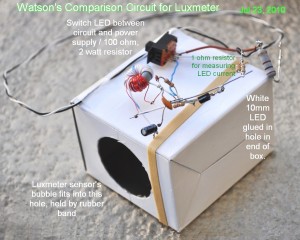Two years ago I decided that I wanted to get a light meter. I had two old light meters for setting a camera, one was a Weston and the other a G.E. Both were not sensitive enought to give an accurate reading of a LED. I had some other choices, one was to use a CdS photocell connected to a DMM set to the kohms range. The light from the LED would give a reading relative to other LEDs or another kight source, but it was not an absolute measurement.
Another way to compare two light sources is to use a grease spot (yes, read this for how it’s done). But the LED is not like a candle flame or light bulb that radiates in all directions. The LED is directional and may have differences in the intensity of the light across its beam, so the measurement could be more difficult. It seemed that the CdS photocell would be the better choice. But it and the ohmmeter make a comparison; the LED’s actual light output in standard units is not known.
 I found that I could buy a Luxmeter online for about $40.00 U.S., which seemed reasonable (it looks exactly like the one in this Youtube video). I ordered one and when I received it I made a jig for it (see the picture). The jig does two things: it holds the LED a fixed distance away and aims it at the luxmeter’s sensor head. The jig also keeps out ambient light so the head only senses the LED light. I used a cardboard box with a small hole cut for the LED and a large hole cut for the luxmeter’s sensor head.
I found that I could buy a Luxmeter online for about $40.00 U.S., which seemed reasonable (it looks exactly like the one in this Youtube video). I ordered one and when I received it I made a jig for it (see the picture). The jig does two things: it holds the LED a fixed distance away and aims it at the luxmeter’s sensor head. The jig also keeps out ambient light so the head only senses the LED light. I used a cardboard box with a small hole cut for the LED and a large hole cut for the luxmeter’s sensor head.
The LED is a 10mm 1 watt white LED. This allows me to measure more than a hundred milliamps, which would be much too high for a regular 5mm LED.
The switch on the top allows me to switch between the Joule Thief circuit shown in the picture, and an externally connected power supply. With the switch set to the Joule Thief, the LED’s light output is measured with the luxmeter. The JT is turned off, the LED is switched to the power supply and the power supply is adjusted until the luxmeter’s reading is the same as the JT reading. The voltage across the large 100 ohm resistor (on the right) is then measured and the current calculated by dividing the voltage by 100 ohms.
Thus I am making two measurements: the actual light output of the LED in Lux, and comparing the light outputs of the JT and power supply The on;y difference between the LED’s light from the Joule Thief and the LED’s light from the power supply is that the power supply is DC and the light is steady, whereas the JT’s current is pulsed so the light output would be pulsed. The luxmeter is made for measuring the light from the fluorescent lights of a room, which is also pulsed at twice the line frequency (100 or 120 Hz), so I see no reason to believe that the pulsed light would give a different reading than the steady light.
I used this setup in my earlier blog where I compare the light output and current of a conventional Joule Thief with my Supercharged Joule Thief.











